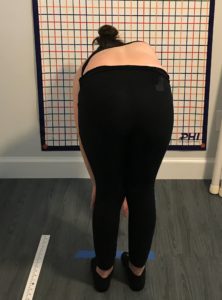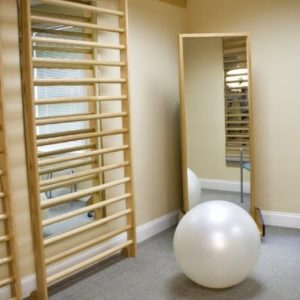How to tell if you have scoliosis

Scoliosis affects roughly 3% of the population. Symptoms of scoliosis include; uneven hips, asymmetry in the rib cage, different height or angle of shoulder blades, and general unevenness of the body.
The most common diagnostic test is the forward bend or Adam’s test. In this Adams test, a person is asked to bend forward slowly and the observer is looking for a rib hump on the back. The Adams test is easy and fast to administer. Doctors can confirm the diagnosis of scoliosis with an x-ray. Once an x-ray is obtained the cobb angle can be calculated. This angel is generally used in determining treatment options.
Treatment Options
Since scoliosis varies greatly case by case, each patient should consult with their doctor or doctors. It’s never a bad idea to get a second opinion to help put together a specialized treatment plan. Scoliosis is not a one size fits all condition. A typical treatment can include bracing, surgery, spinal injections (for pain management), and physical therapy.
For the sake of October being National Physical Therapy Month, we will only focus on physical therapy treatments. Below we have compiled a guide to scoliosis physical therapy, taking a closer look at different methods and techniques. Always consult with your doctor and find a licensed and reputable scoliosis physical therapist before practicing any treatment options. This guide is a resource for anyone looking for scoliosis exercises and physical therapy.
Physical Therapy Options for Scoliosis
Several different schools of thought exist throughout Europe and America with regards to Physiotherapy Scoliosis Specific Exercises (PSSE). Despite their differences, they all use the following as the base for their exercises
1) 3-dimension self-correction;
2) Training activities of daily living (ADL);
3) Stabilization of the corrected posture.
The PSSE’s are not an alternative to bracing or surgery. Instead, the exercises work best in combination with bracing. If surgery is necessary, then scoliosis physical therapy before surgery can help strengthen your core and assist with faster healing. The oldest and most influential physical therapy method for treating scoliosis is the Schroth Method. Below we have put together a list of several other methods of scoliosis physical therapy treatment and their key elements.
The Lyon Approach
Named after the city where it was developed, the Lyon method began in Lyon, France by Jean Claude de Mauroy, MD. Initially, the Lyon method diagnoses each client and then moves into a 5 step program which includes stretching, breathing exercises, and sports (specific to a patient’s Cobb angle). Once they are proficient with the exercised, the clients continue with daily exercises at home both in and out of the brace.
Scientific Exercise Approach to Scoliosis (SEAS)
Developed in Vigevano, Italy by Antonio Negrini and Nevia Verzini using the principles of the Lyon approach though the two scoliosis physical therapy methods do differ in several ways. SEAS uses unassisted exercises and does not adhere to such a stringent program. All exercises resemble activities of daily living, cooking, cleaning, bathing, etc. Above all, the exercises teach clients to maintain correct posture while performing daily activities.
The DoboMed
Short for the Dobosiewicz method, it is a blend of other conservative management approaches along with asymmetrical breathing techniques. Developed in Poland by Krystyna Dobosiewicz, a physiotherapist and physician. The DoboMed focuses on thoracic scoliosis and respiratory dysfunction.
Side Shift
Developed by physiotherapist Tony Betts, the Side Shift method applies the use of lateral movement to auto-correct the curve of the spine. Applying the principles of the Schroth Method, the Side Shift uses lateral trunk shifting movements into the concavity of the spine, giving the method its name.
The Schroth Method
Developed in the early 20th century by Katharina Schroth of Germany. Schroth, suffering from moderate scoliosis and not seeing results using a brace for treatment, began to develop a method of correcting posture with the breath, stretching, and self-correcting. Barcelona Scoliosis Physical Therapy School (BSPTS), founded by Dr. Manuel Rigo in 2009. The school teaches physical therapists the original Schroth principles and advanced concepts in scoliosis treatment. The Schroth Method is the most widely used scoliosis physical therapy treatment to date.
Schroth Method Exercises
Correct Posture
Before beginning any exercise, it is important to find a neutral spine and a correct posture in all 3 dimensions. After a client achieves this correct posture, the exercises begin with axial elongation.
Diaphragmatic Rotational Breathing
Using the breath to build muscle tension into the concave areas in both the front and the back of the spine. The rotational breathing and internal muscle tension is the hallmark of the Schroth Method.
Posture Correction
A correct posture includes understanding your curve and how to expand the concave side of the curve. Begin in a neutral pelvis with the ribs stacked above the hips and elongate your spine.
Stretching
Each scoliosis patient will have some stretching exercises specific to their curve and severity. Importantly, people with scoliosis need to be careful with any rotation and twisting stretching which could increase the curve. Trunk flexion and extension stretches are always approached with caution in people with scoliosis..
Sports
Good news! Most sports are beneficial and can be an effective part of your all-around scoliosis care. Research shows that physical activity can increase calcium in bones to assist with bone strengthening. This is essential for people with scoliosis. When picking a sport, there is some debate about sports that require the use of one side of the body more than the other such as tennis and golf or sports that require twisting and rotation such as dance and gymnastics. The research continues to show that no matter what the sport, it is best to continue to be physically active on a daily basis.
Equipment

Wall Bars
These can be purchased or homemade if you are handy enough. They essentially look like a wide ladder made up of round bars for gripping at different heights.
Tether Strap and Belt
These straps are used to strap yourself by the belt to the bar to create elongation before exercises.
Exercise Ball
A large exercise ball used in a variety of Schroth method exercises. These balls are a great exercise tool to have not only for scoliosis exercise physical therapy, but for a variety of other stretching and strength training routines.
Resistance Bands
These are essentially a large rubber band-like material, with different resistance levels. The bands work well for scoliosis exercises., and are a favorite for scoliosis physical therapy exercises. They take up very little storage space and are used virtually anywhere.
Large Stool / Small Stool
Used for support for scoliosis specific stretches and exercises.
Pull Up Bar
A practical, cheap, and a tight-space friendly piece of equipment. The pull-up bar is used in place of wall bars.
Mirror
used for visual feedback with exercises and positioning.
Yoga Mat
Turn any room into a yoga studio! Great for doing yoga and stretching exercises at home.
In conclusion, always consult your doctor or physical therapist before trying any new exercises. If you have any questions or would like to schedule an appointment to begin your scoliosis physical therapy journey please call (904) 372-3161 or leave a message at our contact page and we will get in touch ASAP!